|
|
|

SCV NEWSMAKER OF THE WEEK:
Jennifer Trosper
Mission Manager, Mars Spirit Rover
Interview by Leon Worden
Signal City Editor
Sunday, June 13, 2004
(Television interview conducted April 15, 2004)
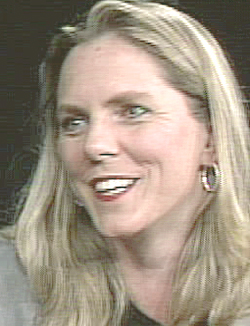
"Newsmaker of the Week" is presented by the SCV Press Club and Comcast, and hosted by Signal City Editor Leon Worden. The half-hour program premieres every Wednesday at 9:30 p.m. on SCVTV Channel 20, repeating Sundays at 8:30 a.m.
This week's newsmaker is Canyon Country resident Jennifer Trosper, surface mission manager of the Spirit rover, which landed Jan. 3 on Mars. The following interview was conducted April 15. Questions are paraphrased and answers may be abbreviated for length.
Signal: What brought you to the Santa Clarita Valley?
Trosper: Actually, the reason I live out here is, I got married a few years ago and my husband works at Edwards Air Force Base. So this is really the only place we can live which is directly in between (Jet Propulsion Laboratory) in Pasadena and Edwards, which is in the middle of the Mojave desert.
Signal: The Spirit mission has been highly successful so far. You haven't found life on Mars, but you've found the next best thing — signs of past liquid water.
Trosper: Right. It's been fantastic. In fact, (April 14) was sol 100, so we hit our century mark: 100 times we've gone and driven the rover or done something each day and explored the rocks, and we have found signs that there was water there in the past. Now, Spirit's at Gusev site, which is about 15 degrees south, and Opportunity's at Meridiani. We've found more evidence of water at the Meridiani-Opportunity site, but we've still found some evidence of water at the Spirit site, as well.
Signal: Sprit landed first. Along comes Opportunity and finds all these things. Do you feel overshadowed?
Trosper: The interesting thing is, the teams are all the same. All the way through the development, we were all working on both rovers. There wasn't even one rover team versus the other rover team. The only — at the point of landing, we decided it was important to split the teams out, just because you need to have somebody who is singly responsible for the health and safety of the rover, which ends up being me for Spirit and (Santa Clarita resident) Matt Wallace for Opportunity.
So yeah, there were days when I kind of likened Opportunity to the rover that grew up in Orange County — landed in the crater that had water in it — and Spirit is sort of her Eastern European sister, you know — she's kind of had a rough time of it. She has to drive really far to find evidence of much water, and she also had the anomaly period where we had the software issue that caused us to maybe stand down for a little bit and try to figure that out.
Signal: Things went dark for a couple weeks. Did you think it was all over?
Trosper: Well, I guess I never really thought it was all over, but certainly I had concerns. I remember a phone call to my husband one day where I say, "How was your day?" And he said, "Oh, not so good." I said, "Well, are you personally responsible for the loss of a $400 million national asset?" And he said no. I said, "Well, (yours was) probably better than mine, anyway."
But I never really thought the rover was gone, because there were so many possibilities of errors or problems that would cause it to not talk to us. I mean, there were so many that if it didn't tell us anything, it was going to be really hard to figure out what was going on. So fortunately, we had about three days where we got, the first day, no communications from it, which was concerning.
Signal: How long had it been on Mars before this happened?
Trosper: Eighteen sols. A sol is a Martian day, which is 36 minutes longer than an Earth day. So for 18 Martian days, Spirit did fantastic, everything is going great, we're about a week from Opportunity landing, where all of a sudden then we have to operate Spirit on the surface and operate Opportunity on the surface. Actually I think it was about five days before Opportunity landing where we lost the Spirit signal. It didn't communicate when it was supposed to...
Initially we thought it was weather at the station, because the Deep Space Network station — sometimes if there's weather, they won't track the signal very well, so there was some weather, there were some problems that morning —
Signal: What do you mean by weather?
Trosper: It means rain. It means rain in Spain can cause you to not hear from your spacecraft. It's rain near the antenna that's trying to listen to the signal. So we thought it was weather, and then we didn't hear the next communications pass, and then we got a communcations pass where the rover talked to — this was one where the rover talks to the orbiter, and then the orbiter talks to Earth — it talked to the orbiter, but it was kind of like, "lights are on, nobody's home" type of communication, where the radios talked but there wasn't any software giving it smart things to tell, so it didn't look like the computer was really operating correctly.
We thought that there might be a hardware problem, and I think that's the point where we said, we're not sure that we're ever going to get back to 100 percent. We didn't know what the hardware problem was, but I remember, we thought, if there is a hardware problem, maybe we can work around it, since we were able to get a signal, but it's not clear that the rover's ever going to be 100-percent healthy again. But then the next day, we actually were sending commands to it to try to get it to talk to us...
Signal: Pinging it.
Trosper: Pinging it. And all we wanted was a beep, you know? It's like, forget the images, forget anything, we just want like one radio signal for a few seconds. We were basically trying to get a five-second beep. And it didn't happen, didn't happen, and then we changed to — if we have a major fault on the spacecraft, it will actually only execute instructions we send it in a certain way. So we sent it in that certain way, which was at a different rate, and we got the beep back, which indicated that a major fault had occurred — which kind of took us down the path of, well, what really bad could have happened? It could have been a power problem or a thermal problem. And then the next day, we actually started to get data from the spacecraft, but the first data we got back from it that wasn't just a beep said the year was 2052.
And we were like, that's not good. Being rocket scientists, we're, like, that's not good. We know it's not 2052.
Signal: A little science fiction thrown in —
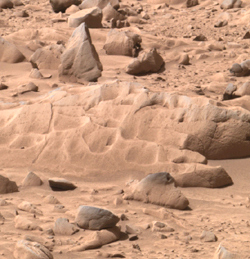
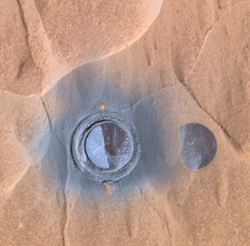
BEFORE AND AFTER: An intriguing outcrop
of volcanic rock (top) yeilds evidence of a water process inside (above) when the Spirit's rock abrasion tool
scrapes away the top layers.
|
|
Trosper: Exactly. Then we went through the data, figured out that that data was wrong, but we're happy that the vehicle is at least trying to tell us something. Got a couple more communications sessions; one of them we got data that basically said, "I'm sending you data," and we're like, "Well that's nice, but give us more info" — and so we tweaked some parameters and got another communications session that indicated to us that we really were in this reset loop with the software, and that the eagle hadn't even shut down for the last couple days. Usually it shuts down at night and wakes up. But we could see that the batteries were discharged and that it was hot enough that it hadn't shut down as much as we had expected.
The software problem that we had was basically keeping the vehicle from responding to the commands we were sending it to shut down. Once we told the software, when it booted, to not look at the flash memory, because the flash was corrupted, then we were able to get it into a stable enough state, by itself, without the flash. Then we would write little programs that would go over and query information in flash and try and figure out what was wrong with the flash memory.
So imagine, Mars is 200 million miles away; the one-way light time to Mars is 15 minutes, and you're trying to debug this problem by saying, OK, well, let's find out this piece of information. So you send the command to get that piece of information and you go and you get your cup of coffee, right? In 15 minutes it gets to the spacecraft and then the spacecraft sends something back. Fifteen more minutes. So half an hour later you get one piece of information about what you were trying to debug.
It took us about a week and a half to get all the information we wanted, to make sure that there wasn't a hardware problem in the flash. Once we figured out that there wasn't, then we reformatted it, and actually, Spirit's 100 percent. We were very excited that it's just like new — in fact, better. We loaded some new software about a week ago and we've put in some fixes so that the memory stays even cleaner than it was in the past. So it's healthier than it's ever been.
Signal: The mission was initially to last three months and has been extended another five months, through September. Talk about the success. What has it found?
Trosper: The thing that we've seen on the rocks at the Spirit site — they're volcanic rocks, and they're similar to volcanic rocks that we've seen at other sites. But in some of the rocks — we have a brush on our rock abrasion tool so we can brush the dust off, and then we'll look at what the rock looks like under the dust. In one case, we abraded even further and what we found was, on top of the basalt, the volcanic part of the rock, there were at least two layers that were placed there by some other process, most likely a water-type or fluid-type process that had washed over these rocks and caused the outside of them to no longer look volcanic but to look like something had affected them. They tend to be the white rocks that we see at the Spirit site that are more like this.
Now, the reason we actually landed in Gusev crater? If you look at it from orbital data, it looks like a big lake with a river flowing into it. You look at that and you go, "There was water there once." But we're not seeing significant evidence of it at Gusev right now. Part of the theory is, there is a lot of cratering, a lot of ejecta from the craters, that has happened over many, many years, causing whatever was there in the past to be covered up with all the ejecta from the craters. So we need to get somewhere else where there's not a lot of ejecta from the craters to really prove that there was a lot of water there.
The thing that's neat about having the extended mission is, if you look at the pictures that Spirit takes, there are these hills. We call them the Columbia Hills. They're in the east. They're these amazing — you look at them and it's kind of like when you, if you like to go and hike and climb mountains you think, we have to go to the hills, we have to climb the hills. So because we've been able to extend the mission, we actually can drive to the hills.
Now, the thing that's interesting about the hills is, they're actually at an elevation that is similar to what appears to be the inflow channel into the Gusev crater. You could convince yourself that those higher elevations are less affected by the ejecta from the craters, so we might see more evidence of some sort of standing water, or water like we see at the Meridiani site, by going to the hills and getting a little bit higher up there. It's going to be a fun drive over there.
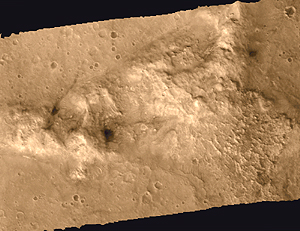
The Columbia Hills, seen here from above in a
satellite image, is a target desintation of the Spirit rover's extended mission.
|
|
Signal: Obviously there is ice at the Martian polar caps, and there is ice under the planet surface. Images from Mars Global Surveyor show rock features that could only have been formed by liquid in the past. So, why is it important to get down on the surface to prove what's already fairly well believed — that there was water there?
Trosper: I think that there is a huge amount of circumstantial evidence from the orbiters that point to the fact that there was water in the past on the surface of Mars. But the real, confirming evidence that we're getting from the instruments now is something that confirms the things we've seen on the orbiters.
If you have instruments that you've sent to Mars and you've calibrated and you know all these things about them but you want to make sure that they're not telling you things that are incorrect, then you send another instrument suite that tests different things, that can come to the same conclusion. So we're confirming what the orbiters have already seen evidence of.
But the other thing that we really want to do is find out — a great example is Gusev, where the orbiters — it looks like there was a huge lake here at one point, but if we were to send our (future) Sample Return Lander to the middle of Gusev crater, we'd end up bringing back a volcanic rock, because that's what we're seeing right now in Spirit.
So to send these rovers to explore ... the surface, they can learn a whole lot more than we can tell from the orbital imaging. Even though we can get great images, it takes a long time to get real high-resolution imaging of the whole surface, so the rovers can actually get some more of that imaging. We can't tell everything about the surface from the orbiters.
Signal: Then is one purpose of the rovers to find a good landing site for a future mission?
Trosper: It's one of them, (but) it's not the prime purpose. The prime purpose is, well, following the water. But once we follow the water and we find the water — evidence of it — then that's the place we want to go back and look at and to bring these rocks back that we see at the Meridiani plain, to Earth. To look at them in an Earth lab would be just a fantastic opportunity. And now we know where they are. We can go and say, "Those are the ones we want to get."
Signal: Tell us about Jennifer Harris Trosper. You grew up on a farm in a town in —
Trosper: Fostoria, Ohio. Buy it wasn't actually in a town.
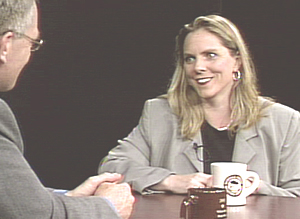 Signal: Your dad built rockets?
Signal: Your dad built rockets?
Trosper: Yeah. My dad worked in the space industry in the ¬50s, kind of right at the very beginning when we were building missiles and rockets for the very first time. He had a lot of neat stories.
Before I was born, they lived out here in Southern California. He worked for Douglas and traveled to White Sands for Douglas and did testing there, and traveled to the Cape (Canaveral) for Douglas, did testing there, traveled over to England and did some installation of some missiles over there. But then, right before I was born, his father passed away and he moved the family back to the farm in Ohio to help his mother with the farm.
So I never really knew him at the time the was working on these rockets, but he had pictures in the den, and my dad was a great storyteller. He would tell me these stories of being in the block house — the block house is the place you go so the rocket doesn't blow you up as it's launching — being the block house and have a rocket, one of these early launches, go south and come screaming across the ground. It just sounded like a really exciting thing to learn about and to do. So I got the itch from my dad's stories.
But I actually — I really liked music, and so I thought I wanted to be a concert pianist. I went to a music camp in high school, for a summer, Interlochen National Music Camp, and I practiced — not as much every day as I should have, but five to eight hours a day, and thought that I wanted to be a concert pianist.
But then, in the mail, I got a flyer from MIT, saying, "Why don't you send an application in?" And I thought, well, why don't I? So I sent an application in to MIT and then they actually admitted me, and I thought, you know, that's probably something I shouldn't turn down, because I can go into engineering. I really liked math and science as well as music, and I thought that I could still do music; in fact I minored in music at MIT and majored in aerospace engineering.
So that all kind of worked out for me. But growing up on the farm, I never thought I'd be a rocket scientist. My summer job was, every summer I'd paint the barn roof, and then I'd paint the trim around the house and I'd cut the trees on the ditch bank and help my dad pull the weeds out of the bean field, and that was kind of my life for awhile, so I don't think I sat there and imagined I'd be a rocket scientist.
Signal: But after MIT, it wasn't a straight course to Pasadena.
Trosper: No, that's true. I worked at a camp for girls for the summer after I graduated from college. We taught girls how to canoe, and we took them on backpacking trips and things like that. I worked with the junior high girls. I found that to be very rewarding. And then I came out to JPL and worked for about three years in the power systems area and the attitude controls system area and I worked on the Cassini spacecraft a little.
But I still kind of had this — in fact when I was in college, I spent some time down in Peru, doing some missionary work. We built cabins for homeless children in a camp for homeless children. I thought that was the coolest thing, and I felt like it was a rewarding experience, so about three years into my career, I thought, I don't want to miss out. I don't want to look back at the end of my life and say I really wish —
Signal: You didn't want to say, "I've only been a rocket scientist and I've only gone to Mars" —
Trosper: Well, you just don't want to have regrets, right? So I thought, well, I can take a year off and do some more missionary work, because I found that to be very rewarding.
I took about two weeks to play on this volleyball team that was in Europe, and I met some people who were interested in doing some missionary work. We decided we wanted to go to the former Soviet Union. We actually taught English there, and then we had Bible study with our students who were interested in doing that.
I lived in a city called Sevastopol, Ukraine. It's right on the tip of the Crimean Peninsula. It was were the Black Sea fleet was. It's where the Crimean War was fought, largely, in that area, and obviously in Sevastopol. So I lived there for a year, and they only had about eight foreigners in the entire city because it was a closed military city for so long.
This was ¬94, so it was not too long after the (Berlin) Wall had fallen down and chaos was everywhere and the mafia is running everything. It was a fascinating experience. But I just loved the people. The Russian people have such depth to their souls, and they're so generous. I mean, people who had saved their whole lives for a car and lost it because the ruble crashed, would go out and buy the most expensive wine and champagne they could because they wanted to have the Americans over for dinner. They would spend their monthly salary on that.
It was humbling to be around people who are so generous in that way, and I loved the Russian people.
Signal: You returned to Pasadena —
Trosper: I was traveling around Europe with some friends after we finally got out of — it took us a while to get out of Ukraine. We finally got out of Ukraine — planes, trains and automobile-type stuff getting out of Ukraine. I sent a postcard to a friend at JPL — I took a leave of absence from JPL and they said, "No guarantees, but if we have something when you are ready to come back, we'll try to give you a job." I said, "I'm going to be back in Ohio in July; do you guys have anything for me to do?" And the day I got home in Ohio, this guy, Joe Savino, called me and said, "There's this new project called Mars Pathfinder, and people aren't sure it's going to work — you know, it's kind of a Skunk Works-type thing, but we need some people to work on that, and would you be interested?" And I was like, "Yeah, of course." And that was a huge opportunity for me, because Mars Pathfinder was the first real project I had worked on where I got experience with the hardware and the software and putting things together and testing it.
Signal: And Pathfinder was the demonstration model for what you're doing now.
Trosper: Right. That was the demonstration model for MER (Mars Exploration Rovers).
Signal: How did you progress to being in charge of one of the rovers?
Trosper: Yeah, that's a good question. I wonder that myself. Well, Mars Pathfinder — I started out as a test bed engineer, so I worked in the test bed, and when people wanted things to be tested, I would set the — in this particular case — the lander up, the Pathfinder lander up the right way and do testing, and as a result of being a test bed engineer I ended up being the lead engineer for testing the surface mission. Which on Pathfinder was focused on the first two days, really, because we wanted to land safely, and then we wanted to get the rover off the lander and driver the rover. So it was much simpler than MER.
As a result of being the tester focused on that — Pathfinder was kind of small — I became the flight director for landing day on Mars Pathfinder, because I was the one who was closest to what was really going to happen those days. So that was a neat opportunity, to do that. And then there were several other flight directors and we swapped off. After Pathfinder I actually went off to do systems engineering on the Mars 2001 Odyssey orbiter, and that's now at Mars, and was the development manager for operations on that after I did the system engineering role.
Then I got married and took a few months off JPL, and when I came back, there was this new project that was the marrying of Pathfinder and the rover and the payload, and I just couldn't stay away because it looked like it was the coolest thing going — and it was. So I interviewed with, ironically, the guy who — I had two job offers when I first was coming to JPL, one was from (MER program manager) Pete Theisinger and one was from John Klein, and I took the one from John Klein and worked in the power system and then interviewed with Pete Theisinger to be his project system engineer. He's the project manager, and project system engineer is the "big picture" system engineer who has to make sure everything fits together between the flight system and the mission system and the science, the mission system being the operations design and everything...
So I became in charge of the system design, and then once you're in charge of the system design, you end up being responsible for the system verification program. (By) "system level," I mean, we have to test this mission like we fly it. So we had to design tests that would exercise the spacecraft like it would be exercised in crews, but do it on Earth, and design a similar test for the surface. So I worked the verification, and then once we launched, since we still weren't done, I kind of got the "and finish it all" flight software-ground software testing job...
Because I had worked the system design and a lot of the verification program, it was kind of natural to have me go and be one of the mission managers.
Signal: As mission manager, you're in charge of doing what, exactly? Do you decide where the rover goes each day?
Trosper: Well, actually, it's more like I have veto power. I work with the science team — there's an engineering team, there's a science team. The engineering team looks at how well the rover did today on its objectives, if it drove or it was using the arm on the rock. And we say, "OK, the rover did great; here's how much energy we have to allocate to science tomorrow. Here's how much data volume we have that's available for science tomorrow, here's how much time we have that's available for science tomorrow," and then we talk to the science folks about what they want to do...
The nice thing about our science team is, we did about seven operational readiness tests before we landed, and these were tests where we were still on Earth and we were using the rovers in our test beds and we were pretending we were on Mars. And as is always the case when you're trying to simulate the universe, which is what we were trying to do because we weren't actually on Mars, and then drive the rovers, the tests were just disastrous. One thing after another went wrong, so we really trained the scientists that things weren't quite going to work as well as they thought.
So once we got to the surface, and the universe does its thing, and we don't have to simulate it anymore, so (we're) less likely to mess that part up — they actually, I think, have gotten a lot more out of this mission than perhaps they thought at the beginning when we were doing these operational readiness tests.
Signal: So it's not quite like, they say "let's go here," and you say "no."
Trosper: No. in fact, this science team, because they've sort of been through it with us, it's definitely more like one team. They say, "We want to go to this rock," and we'll do everything we can to get there. But if we think it's not safe — I mean, my job is to make sure that — it's my problem if something happens that's bad to the rover. So I need to make sure we that we don't make decisions that would cause something bad to happen — make sure we don't drain the batteries too much, that we thermally are heating things properly, we're not damaging any hardware.
I mean, the worst thing would be to approve something and then go and damage the rover. You can't get up there with a wrench or whatever and fix it. So that's what we do. We make sure that things go right.
Signal: What's up with the music you use to wake up the rover each morning?
Trosper: Nowadays? Not much, actually. We have to sometimes rack our brains quite a bit to figure out what the most appropriate song is, but it's kind of a fun thing we like to do to break up the monotony of Mars time —
Signal: Sure. What you're doing is sooo boring —
Trosper: Well, the round-trip light time of 30 minutes gives you lots of time to pick out music.
Signal: If one sol is 36 minutes longer than an Earth day, then over the first three months, the difference is about 60 hours. So you're waking up in the middle of the night and going to work and coming home and going to bed in the middle of the day?
Trosper: Yup. It rotates around. Some people want more time in their day, so we at least have that.
See this interview in its entirety today at 8:30 a.m., and watch for another "Newsmaker of the Week" on Wednesday at 9:30 p.m. on SCVTV Channel 20, available to Comcast and Time Warner Cable subscribers throughout the Santa Clarita Valley.
©2004 SCVTV.
|
|
|